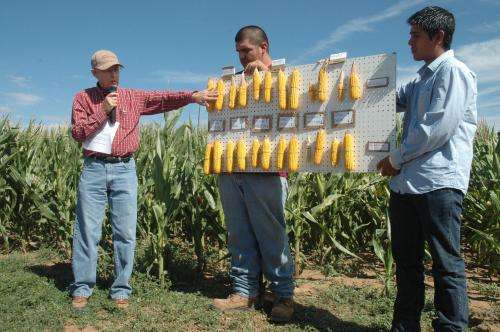AgriLife Extension expert: Spider mite damage to corn affected by irrigation level

Spider mite infestations on corn and the damage done will vary under different irrigation levels and could dictate slight changes in management practices, according to a Texas AgriLife Extension Service specialist.
Dr. Ed Bynum, AgriLife Extension entomologist in Amarillo, is wrapping up the first year of a two-year study on spider mite infestations under different irrigation levels and with different corn hybrids at the North Plains Research Field near Etter.
"As producers begin to use drought-tolerant corn hybrids, one of the questions they have is whether drought tolerance will provide some level of protection against spider mites or if the added stress from spider mites will break down the drought tolerance," Bynum said.
The study was designed with three irrigation levels: 100 percent evapotranspiration, 75 percent and 50 percent; and four corn hybrids: two non-drought-tolerant commercial corn hybrids and two drought-tolerant corn hybrids.
The spider mite damage is caused when they puncture the cells on the leaf and remove the chlorophyll, Bynum said. As mite feeding increases, greater leaf area is damaged and entire leaves can be killed. This reduces the photosynthesis, thus reducing grain yield.
"Since we know spider mite populations increase faster under moisture-stress conditions, during grain-filling growth stages and under higher temperatures, we suspected the impact on drought-tolerant corn hybrids under different irrigation levels could be significant," he said. "The mite feeding reduces the plant water-use efficiency, which is robbing your crop of water that is applied through irrigation."
Bynum said they had significant numbers of mite infestations, up to about 4,000 mites per plant by the end of the test period, and so they did see a progression of damage through the weekly testing. The high number of mites appeared across the board, under all irrigation levels and on all corn hybrids.
The significant difference was seen in the progression of damage between drought-tolerant and non-drought-tolerant corn hybrids, he said. Under the 100 percent evapotranspiration level, non-drought-tolerant corn hybrids had progressively higher mite damage than the drought-tolerant. Under the 50 percent irrigation level, there was significant damage regardless of drought tolerance in the corn hybrids.
At the 75 percent evapotranspiration level, the damage was either similar to or higher in the drought-tolerant hybrids than the non-drought-tolerant hybrids, Bynum said.
"This initially indicates that under a moderate level of stress, the drought-tolerant corn hybrids did not withstand mite damage," he said. "The mite-to-damage ratio indicates we have lower water-use efficiency at this irrigation level."
This also indicates as producers begin to use drought-tolerant corn hybrids, there could be a difference in economic injury levels under different moisture conditions, Bynum said.
"It's not that they shouldn't use drought-tolerant hybrids, but they will need to be aware of possible management decisions for spider mite treatment that could be required," he said.
Provided by Texas A&M University



















